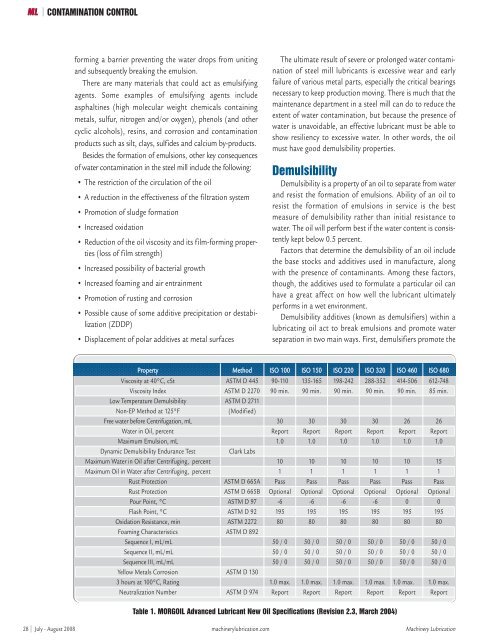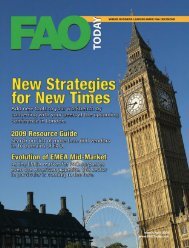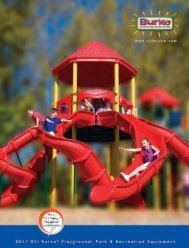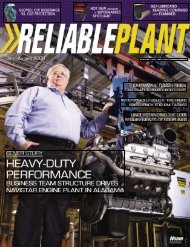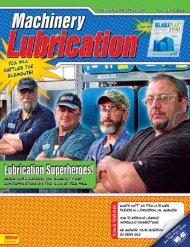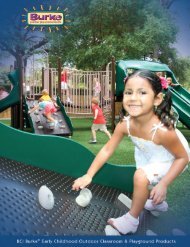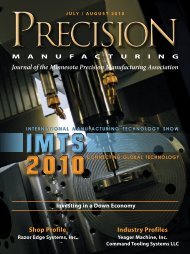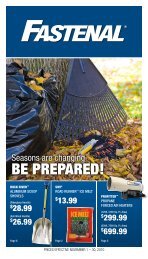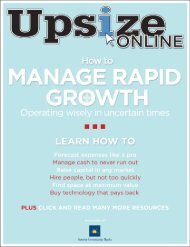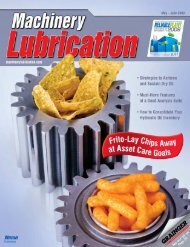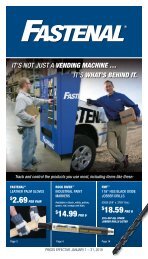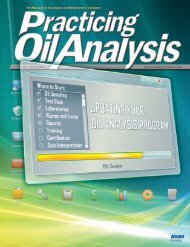Machinery Lubrication July August 2008
Machinery Lubrication July August 2008
Machinery Lubrication July August 2008
You also want an ePaper? Increase the reach of your titles
YUMPU automatically turns print PDFs into web optimized ePapers that Google loves.
CONTAMINATION CONTROL<br />
forming a barrier preventing the water drops from uniting<br />
and subsequently breaking the emulsion.<br />
There are many materials that could act as emulsifying<br />
agents. Some examples of emulsifying agents include<br />
asphaltines (high molecular weight chemicals containing<br />
metals, sulfur, nitrogen and/or oxygen), phenols (and other<br />
cyclic alcohols), resins, and corrosion and contamination<br />
products such as silt, clays, sulfides and calcium by-products.<br />
Besides the formation of emulsions, other key consequences<br />
of water contamination in the steel mill include the following:<br />
• The restriction of the circulation of the oil<br />
• A reduction in the effectiveness of the filtration system<br />
• Promotion of sludge formation<br />
• Increased oxidation<br />
• Reduction of the oil viscosity and its film-forming properties<br />
(loss of film strength)<br />
• Increased possibility of bacterial growth<br />
• Increased foaming and air entrainment<br />
• Promotion of rusting and corrosion<br />
• Possible cause of some additive precipitation or destabilization<br />
(ZDDP)<br />
• Displacement of polar additives at metal surfaces<br />
The ultimate result of severe or prolonged water contamination<br />
of steel mill lubricants is excessive wear and early<br />
failure of various metal parts, especially the critical bearings<br />
necessary to keep production moving. There is much that the<br />
maintenance department in a steel mill can do to reduce the<br />
extent of water contamination, but because the presence of<br />
water is unavoidable, an effective lubricant must be able to<br />
show resiliency to excessive water. In other words, the oil<br />
must have good demulsibility properties.<br />
Demulsibility<br />
Demulsibility is a property of an oil to separate from water<br />
and resist the formation of emulsions. Ability of an oil to<br />
resist the formation of emulsions in service is the best<br />
measure of demulsibility rather than initial resistance to<br />
water. The oil will perform best if the water content is consistently<br />
kept below 0.5 percent.<br />
Factors that determine the demulsibility of an oil include<br />
the base stocks and additives used in manufacture, along<br />
with the presence of contaminants. Among these factors,<br />
though, the additives used to formulate a particular oil can<br />
have a great affect on how well the lubricant ultimately<br />
performs in a wet environment.<br />
Demulsibility additives (known as demulsifiers) within a<br />
lubricating oil act to break emulsions and promote water<br />
separation in two main ways. First, demulsifiers promote the<br />
Property Method ISO 100 ISO 150 ISO 220 ISO 320 ISO 460 ISO 680<br />
Viscosity at 40°C, cSt ASTM D 445 90-110 135-165 198-242 288-352 414-506 612-748<br />
Viscosity Index ASTM D 2270 90 min. 90 min. 90 min. 90 min. 90 min. 85 min.<br />
Low Temperature Demulsibility ASTM D 2711<br />
Non-EP Method at 125°F<br />
(Modified)<br />
Free water before Centrifugation, mL 30 30 30 30 26 26<br />
Water in Oil, percent Report Report Report Report Report Report<br />
Maximum Emulsion, mL 1.0 1.0 1.0 1.0 1.0 1.0<br />
Dynamic Demulsibility Endurance Test<br />
Clark Labs<br />
Maximum Water in Oil after Centrifuging, percent 10 10 10 10 10 15<br />
Maximum Oil in Water after Centrifuging, percent 1 1 1 1 1 1<br />
Rust Protection ASTM D 665A Pass Pass Pass Pass Pass Pass<br />
Rust Protection ASTM D 665B Optional Optional Optional Optional Optional Optional<br />
Pour Point, °C ASTM D 97 -6 -6 -6 -6 0 0<br />
Flash Point, °C ASTM D 92 195 195 195 195 195 195<br />
Oxidation Resistance, min ASTM 2272 80 80 80 80 80 80<br />
Foaming Characteristics ASTM D 892<br />
Sequence I, mL/mL 50 / 0 50 / 0 50 / 0 50 / 0 50 / 0 50 / 0<br />
Sequence II, mL/mL 50 / 0 50 / 0 50 / 0 50 / 0 50 / 0 50 / 0<br />
Sequence III, mL/mL 50 / 0 50 / 0 50 / 0 50 / 0 50 / 0 50 / 0<br />
Yellow Metals Corrosion ASTM D 130<br />
3 hours at 100°C, Rating 1.0 max. 1.0 max. 1.0 max. 1.0 max. 1.0 max. 1.0 max.<br />
Neutralization Number ASTM D 974 Report Report Report Report Report Report<br />
Table 1. MORGOIL Advanced Lubricant New Oil Specifications (Revision 2.3, March 2004)<br />
28 <strong>July</strong> - <strong>August</strong> <strong>2008</strong> machinerylubrication.com <strong>Machinery</strong> <strong>Lubrication</strong>


